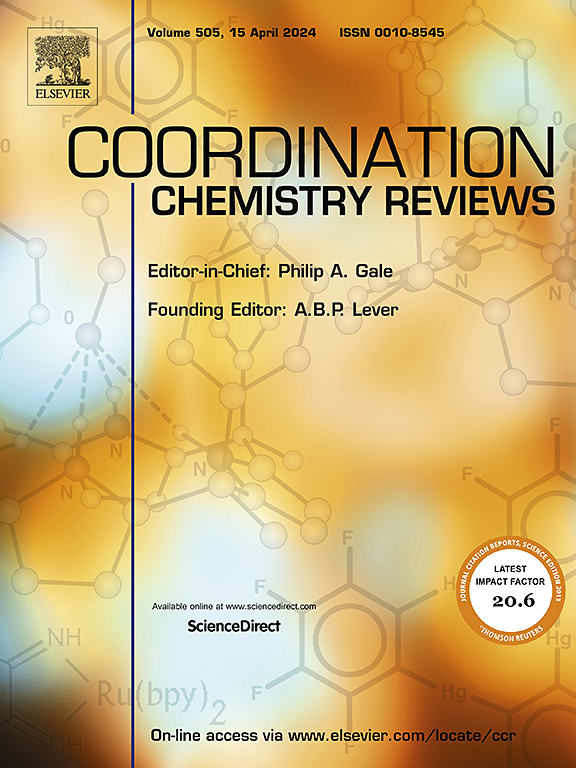Interface engineering of transition-metal-based electrocatalysts for alkaline water splitting
IF 23.5
1区 化学
Q1 CHEMISTRY, INORGANIC & NUCLEAR
引用次数: 0
Abstract
As global fossil fuel reserves diminish and environmental concerns escalate, the quest for sustainable alternative energy sources has become increasingly urgent. Among various methods for hydrogen production, water electrolysis stands out as a promising approach due to its efficiency and environmental compatibility. However, the high overpotential inherent in this process necessitates additional energy input, thereby compromising overall energy conversion efficiency. Non-precious transition metals such as iron, cobalt, and nickel have emerged as attractive candidates for electrocatalysis owing to their abundant supply and diverse structural compositions. Nevertheless, their inherent challenges including low conductivity, limited catalytic activity, and a restricted number of active surface sites pose significant barriers to their widespread applications. This review focuses on the utilization of transition metal nanomaterials and employs interface engineering strategies to construct heterointerfaces, aimed at mitigating these intrinsic limitations and enhancing electrocatalytic performance. Special emphasis is placed on understanding the surface and interface effects that dictate the electrocatalytic properties of these catalysts. Types of interface structures are also categorized and introduced. Furthermore, the progress achieved in heterostructure design through interfacial component coupling effects is comprehensively summarized. Finally, in light of current advancements and applications in interface engineering strategies, the review discusses the challenges associated with future heterostructure catalysts and proposes potential solutions.

碱水裂解过渡金属基电催化剂的界面工程
随着全球化石燃料储量的减少和环境问题的加剧,对可持续替代能源的追求变得越来越迫切。在各种制氢方法中,水电解因其效率和环境兼容性而成为一种有前途的方法。然而,在这个过程中固有的高过电位需要额外的能量输入,从而损害整体能量转换效率。非贵重过渡金属,如铁、钴和镍,由于其丰富的供应和多样的结构组成,已成为电催化的有吸引力的候选者。然而,它们固有的挑战,包括低导电性、有限的催化活性和有限数量的活性表面位点,对它们的广泛应用构成了重大障碍。本文综述了过渡金属纳米材料的应用,并采用界面工程策略构建异质界面,旨在减轻这些内在限制,提高电催化性能。特别强调的是理解决定这些催化剂电催化性能的表面和界面效应。对界面结构的类型进行了分类和介绍。综述了利用界面组分耦合效应设计异质结构的研究进展。最后,根据界面工程策略的最新进展和应用,本文讨论了未来异质结构催化剂面临的挑战,并提出了可能的解决方案。
本文章由计算机程序翻译,如有差异,请以英文原文为准。
求助全文
约1分钟内获得全文
求助全文
来源期刊

Coordination Chemistry Reviews
化学-无机化学与核化学
CiteScore
34.30
自引率
5.30%
发文量
457
审稿时长
54 days
期刊介绍:
Coordination Chemistry Reviews offers rapid publication of review articles on current and significant topics in coordination chemistry, encompassing organometallic, supramolecular, theoretical, and bioinorganic chemistry. It also covers catalysis, materials chemistry, and metal-organic frameworks from a coordination chemistry perspective. Reviews summarize recent developments or discuss specific techniques, welcoming contributions from both established and emerging researchers.
The journal releases special issues on timely subjects, including those featuring contributions from specific regions or conferences. Occasional full-length book articles are also featured. Additionally, special volumes cover annual reviews of main group chemistry, transition metal group chemistry, and organometallic chemistry. These comprehensive reviews are vital resources for those engaged in coordination chemistry, further establishing Coordination Chemistry Reviews as a hub for insightful surveys in inorganic and physical inorganic chemistry.
 求助内容:
求助内容: 应助结果提醒方式:
应助结果提醒方式:


